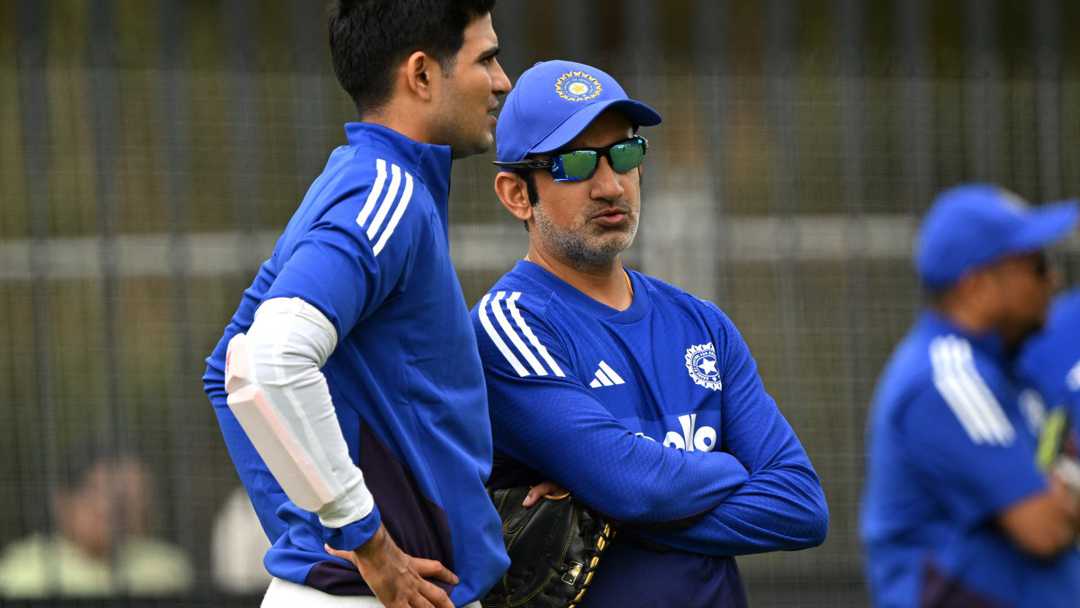
Comparing everything to NZ Tests is the wrong narrative: Gambhir
South Africa wrapped up their inevitable 2–0 series win before lunch on Day 5 in Guwahati, leaving Gautam Gambhir with an unflattering home record: Played 9, Won 4, Lost 5. All five of those losses have come in the last 12 months.
Gambhir, however, strongly rejected the idea of bundling the series defeats to New Zealand and South Africa together.
“Look, first of all, the series against New Zealand, we had a very different side,” Gambhir said. “This is a very different side. The experience that team had compared to what this team has is chalk and cheese.”
India’s top five in the New Zealand series last October featured Rohit Sharma, Virat Kohli, and KL Rahul. Now, Rahul has moved up the order, Shubman Gill has shifted to No. 4, and the No. 3 slot remains in flux—with Sai Sudharsan edging out Karun Nair more on potential than runs.
“Comparing everything to New Zealand is probably a wrong narrative,” Gambhir insisted. “If you see, 4 or 5 batters in this top eight have literally played less than 15 Test matches and they will grow. They’re learning on the job. Test cricket is never easy when you’re playing against a top-quality side.”
“You’ve got to give them time. I hate using the word ‘transition’, but this is exactly what transition is. When your batting line-up has played less than 15 to 18 Tests, they need time to absorb pressure and improve against quality attacks.”
But questions remain over whether the team management is aiding that growth. Shubman Gill’s injury forced one change, but Washington Sundar alone has batted in six different positions in his last eight Test innings. After being tried at No. 3 in Kolkata, he was relegated to No. 8 a week later in Guwahati.
India’s transition isn’t limited to batting. Ravichandran Ashwin’s departure in December 2024 left a major void. India haven’t found an off-spinner of comparable quality or potential. Washington Sundar—India’s current off-spinner—has played more Tests (17) than first-class matches (16) for Tamil Nadu.
“Look, that’s why we are giving as many opportunities as we can to someone like Washi,” Gambhir said. “But if you expect Washi to deliver straight away what Ashwin did after playing more than 100 Tests, it’s unfair on that young kid. He is learning his trade.”
India’s reliance on Washington also reflects a team ideology: losing Rohit and Kohli has pushed Gambhir to pack the side with all-rounders, hoping to offset a lack of batting quality with quantity. That worked on flat wickets in England, where Washington wasn’t a primary bowler and contributed lower-order runs. In India, however, he became one of the main bowling protagonists—and was comfortably outbowled by South Africa’s Simon Harmer.
Harmer arrived in India as the first South African with 1,000 first-class wickets. His experience showed as he relentlessly attacked India’s top order and finished the series with 17 wickets.
“That is why it is called transition,” Gambhir said. “I don’t think ever in Indian cricket something like this has happened where transition is happening in both spin bowling and batting. Normally when your batting is secure, your team goes through a bowling transition. But with this Test team, transition is happening in both skill sets.”
Harmer also benefited from a preparatory tour of Pakistan. South Africa captain Temba Bavuma spoke of leaving no stone unturned before the India tour. By contrast, India were in Australia for a T20I series until November 8, with the Eden Gardens Test starting less than a week later.
“Look, obviously scheduling does make a difference,” Gambhir admitted. “Imagine three days before the first Test we were in Australia. Suddenly you come back and have two days to plan with the Test side. I’m not giving that as an excuse, but sometimes we can probably prioritise this better.”
“We can have more gaps so we can work on certain skill sets. Working for two days on a skill set, when we knew they had quality, experienced spinners—that was always going to be a challenge.”
Despite the variables, South Africa served a grim reminder: India are beatable at home. That shift has stained Gambhir’s coaching profile and raised questions about his suitability for the role.
“It is up to the BCCI to decide,” Gambhir said of his future. “I said during my first press conference: Indian cricket is important, I’m not important. And I sit here and say exactly the same thing.”
“People can keep forgetting—I’m the same guy who got results in England with a young team. And I’m sure you’ll forget soon, because a lot of people keep talking about New Zealand. I’m the same guy who won the Champions Trophy and Asia Cup.”
Before India’s next Test assignment in the second half of 2026, they could add another white-ball trophy under Gambhir. But when Test cricket resumes, the narrative will inevitably return to the home shortcomings—and what has been learned since.


